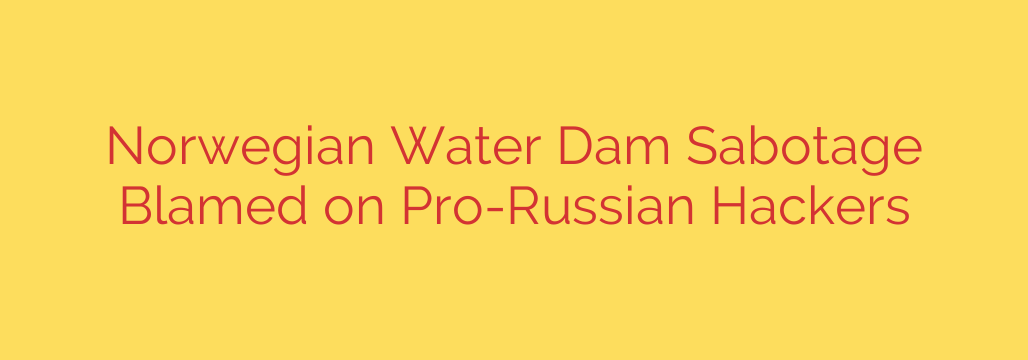
Norway’s Critical Infrastructure Breached: Pro-Russian Hackers Sabotage Water Dam
In a stark reminder of the growing threat to national infrastructure, a cyberattack recently targeted a water and wastewater facility in Norway, leading to significant operational disruptions. Pro-Russian hackers have claimed responsibility for the incident, marking a serious escalation in the use of cyber warfare against essential public services.
The attack successfully manipulated the facility’s industrial control systems, causing a critical failure. According to reports, the hackers were able to sabotage a dam by opening a floodgate, leading to an uncontrolled release of water. While local authorities managed the situation without any reported harm to the public, the event highlights the profound vulnerability of physical infrastructure to digital threats. This incident is not just a data breach; it represents a direct, real-world impact on a nation’s critical systems.
A New Frontline: The Vulnerability of Operational Technology
This attack underscores a critical distinction between traditional IT security and the security of operational technology.
- Information Technology (IT) systems manage data—think office networks, email servers, and customer databases.
- Operational Technology (OT) systems manage physical processes and machinery—like turbines in a power plant, valves in a water treatment facility, or robotics on a factory floor.
The strike on the Norwegian facility was a classic OT attack. The perpetrators didn’t steal data; they interfered with the physical world by manipulating the Industrial Control Systems (ICS) that govern the dam’s operations. Such attacks are particularly dangerous because they can cause immediate physical damage, service outages, and even pose a threat to public safety.
Geopolitical Tensions Spill into Cyberspace
The group claiming responsibility, a known pro-Russian hacktivist collective, has framed the attack as retaliation for Norway’s support of Ukraine. This positions the sabotage as a clear example of hybrid warfare, where digital attacks are used to achieve geopolitical goals. By targeting essential services like water and power, these groups aim to create disruption, instill fear, and pressure governments.
This trend is on the rise globally. Hacktivist groups, often operating with tacit or direct state support, are increasingly targeting critical infrastructure in nations they consider adversaries. The goal is to demonstrate capability and exert influence far from traditional battlefields.
Key Security Measures to Protect Critical Infrastructure
The Norwegian incident serves as a critical wake-up call for utility operators and governments worldwide. Protecting these essential services requires a dedicated and robust approach to cybersecurity. Here are several crucial steps that organizations must take:
- Strict Network Segmentation: One of the most effective defenses is to create a strong “air gap” or digital barrier between IT and OT networks. An infection on the corporate email system should never be able to cross over and affect the industrial machinery.
- Robust Access Control: Implement the principle of least privilege, ensuring employees and systems only have access to the data and controls absolutely necessary for their jobs. Multi-factor authentication (MFA) should be mandatory for any access to sensitive OT systems.
- Continuous Monitoring and Anomaly Detection: Actively monitor OT networks for unusual behavior. Sophisticated monitoring tools can detect unauthorized commands or abnormal system activity, providing an early warning before damage can be done.
- Develop a Resilient Incident Response Plan: Organizations must have a clear, well-rehearsed plan for what to do when an attack occurs. This includes steps to isolate affected systems, switch to manual controls if necessary, and communicate with authorities and the public.
- Regular Security Audits and Updates: Legacy OT systems are often a weak point. It is vital to conduct regular security audits, apply patches promptly, and upgrade outdated hardware and software to eliminate known vulnerabilities.
The line between the digital and physical worlds has been erased. As this attack demonstrates, a keyboard in one country can now open a floodgate in another. Protecting our water, power, and other essential services is no longer just a matter of physical security; it is one of the most urgent cybersecurity challenges of our time.
Source: https://www.bleepingcomputer.com/news/security/pro-russian-hackers-blamed-for-water-dam-sabotage-in-norway/








